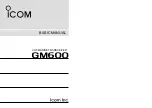
24
25
English
English
21 CTC.S
CTCSS scan
scans the actual channel for CTCSS codes
22 DCS.S
DCS scan
scans the actual channel for DCS codes
23 LED
background light - On, Off, Auto
On
: permanently on
Off
: permanently off
Auto
: the background light turns automatically on, for a few seconds, after any key
operation, except for the PTT key.
24 ROGER
roger tone - Off, 1-10
The roger tone marks the end of the signal. There are ten different roger tones available.
25 SADD
channel scan list - ADD / DEL (delete)
The actual channel can be manually added to (
ADD
), or deleted from (
DEL
), the scan list.
The channel scan list can also be edited via software.
Note: This function is not available in VFO mode (TeCom-Duo-H only).
26 NAME
channel name
Programming of the 7-digit channel name with the following symbols
a) empty space,
b) numbers
0 - 9
,
c) letters
A - Z
and
d) the symbols ( ) ,
< > / usw.
Use the rotary channel selector (3) to select a symbol. To proceed to the next digit, press the
number key [#] (9).
Note: This function is not available in VFO mode (TeCom-Duo-H only).
CALL TONE
DTMF
The TeCom-Duo, in the versions -C and -H, can be programmed with the calling tone system
DMTF.
General:
- The twin function key (15) has to be programmed with the function
Optional Signal Call
for
the calling system to be available.
- Each channel can be individually assigned to DTMF.
- A radio ID (ID Code) serves as the only available decode.
- Encodes are to be programmed either via software (a maximum of 9 encodes) or manually
entered via keypad.
The following settings are available for the calling systems via software:
DTMF
- one decode
- max. 7 encodes
- deactivation of transmission (TX Stun)
- reactivation of the transmission mode (Cancel TX Stun)
- deactivation of transmission and reception mode (RX/TX Stun)
- deactivation of transmission and reception mode (Cancel RX/TX Stun)
- alert and transpond of the code) - Off, Alert, Transpond, Transpond ID-Code
To transmit a call, use one of the following procedures:
1. Press the twin function key (15), the display reads
CALL?
. Enter the number of the
programmed code. The selected code will be displayed. To transmit the selected code, press
the PTT key (14). To abort the procedure, turn the rotary channel selector (3) clockwise. To
modify the selected code, turn the rotary channel selector (3) counterclockwise. Per step, one
digit will be deleted starting from the end. For new entry of deleted digits, use the key pad. To
transmit the code, press the PTT key (14).
2. To enter the code manually via keypad, press the menu key [
MENU
] (13), followed by the
number key 9. The display reads
DTMF
,
5-Ton
or
MSK
.
Now, enter the code via keypad with the available symbols (0-9, *, # and the letters A (MENU), B
(ENTER), C (ESC/M), D (twin function key (15)).
CONNECTION
The TeCom-Duo has a Kenwood-compatible connection (3.5 / 2.5 mm - stereo / stereo), for
earphone/microphone and the software transfer cable.
For further accessory check our TEAM catalogue or our web site at www.team-electronic.de.
tecom-duo_manual4:TeCom-X5 manual 3/7/2013 11:18 AM Seite 24













































